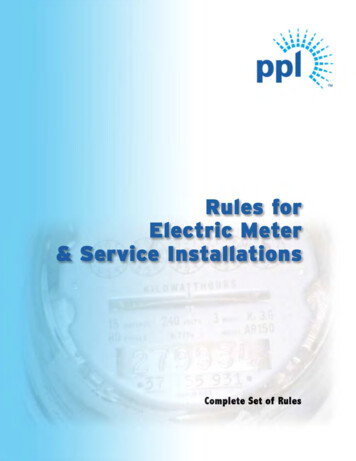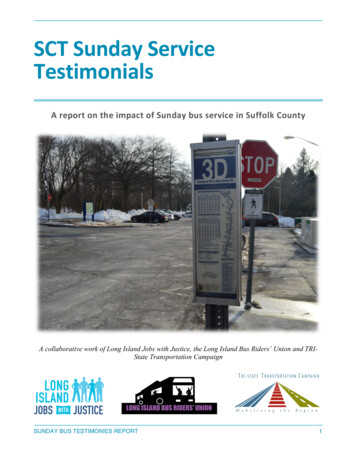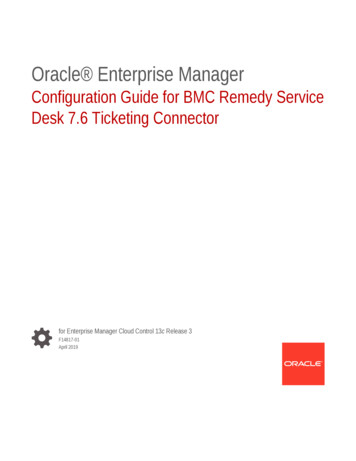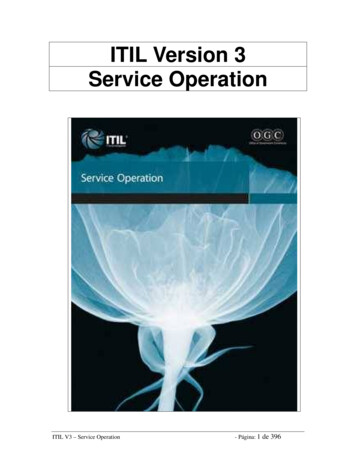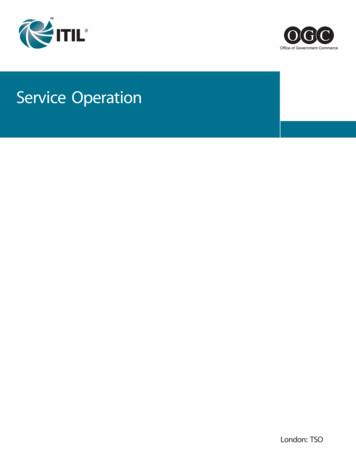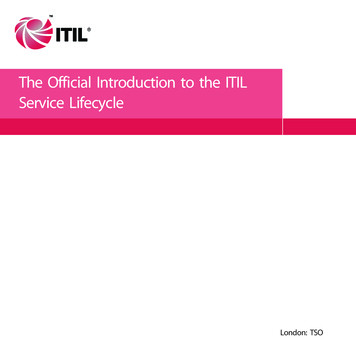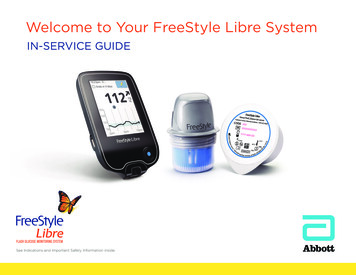
Transcription
Welcome to Your FreeStyle Libre SystemIN-SERVICE GUIDESee Indications and Important Safety Information inside.
Important Safety InformationIndications For UseThe FreeStyle Libre Flash Glucose Monitoring System is a continuous glucose monitoring (CGM) device indicated for the management of diabetes in personsage 18 and older. It is designed to replace blood glucose testing for diabetes treatment decisions. The System detects trends and tracks patterns aiding in thedetection of episodes of hyperglycemia and hypoglycemia, facilitating both acute and long-term therapy adjustments. Interpretation of the System readingsshould be based on the glucose trends and several sequential readings over time. The System is intended for single patient use and requires a prescription.ContraindicationsMRI/CT/Diathermy: The FreeStyle Libre Flash Glucose Monitoring System must be removed prior to Magnetic Resonance Imaging (MRI), ComputedTomography (CT) scan, or high-frequency electrical heat (diathermy) treatment. The effect of MRI, CT scans, or diathermy on the performance of theSystem has not been evaluated. The exposure may damage the Sensor and may impact proper function of the device which could cause incorrect readings.WARNINGS Do not ignore symptoms that may be due to low or high blood glucose: If you are experiencing symptoms that are not consistent with your glucosereadings, consult your health care professional. Checking Sensor glucose readings with a blood glucose meter: Under the following conditions, Sensor glucose readings may not be accurate andyou should conduct a fingerstick test using a blood glucose meter. You should not use Sensor glucose readings to make a diabetes treatment decision: If you suspect that your reading may be inaccurate for any reason When you are experiencing symptoms that may be due to low or high blood glucose When you are experiencing symptoms that do not match FreeStyle Libre System readings During times of rapidly changing glucose (more than 2 mg/dL per minute), when interstitial fluidglucose levels as measured by the Sensor may not accurately reflect blood glucose levels When the Sensor glucose reading does not include a Current Glucose number or Glucose Trend Arrow In order to confirm hypoglycemia or impending hypoglycemia as reported by the Sensor When you see thesymbol, you must check your blood glucose with a blood glucose meter before making any treatment decisions.Sensor readings may not accurately reflect blood glucose levels. Hypoglycemic unawareness: The FreeStyle Libre System has not been evaluated for use in patients with hypoglycemic unawareness and willnot automatically alert you of a hypoglycemic event without you scanning your Sensor. No alarms without a Sensor scan: The FreeStyle Libre System does not have alarms that will automatically notify you when you are having a severelow (hypoglycemic) or high (hyperglycemic) glucose event unless you scan your Sensor. For example, the System does not have an alarm that canalert or wake you when you are sleeping in the case of low or high glucose. Choking hazard: The FreeStyle Libre System contains small parts that may be dangerous if swallowed.Glucose GoingLow35092mgdL250150502pm6pmCautions and LimitationsBelow are important cautions and limitations to keep in mind so you can use the System safely. They are grouped into categories for easy reference.What to know about Alarms/Alerts: There are NO alarms or alerts unless you scan the Sensor.What to know before using the System: Review all product information before use. Take standard precautions for transmission of blood borne pathogens to avoid contamination.SafetyInformation10pm
Important Safety InformationWho should not use the Systems: Do not use the System in people less than 18 years of age. The System is not approved for use in people under 18 years of age and Sensor readings inthis population may be inaccurate. In general, continuous glucose monitoring systems are recognized to be less accurate in children than in adults. Do not use the System in critically ill patients. The System is not approved for use in these patients. It is not known how different conditions ormedications common to the critically ill population may affect performance of the System. Sensor glucose readings may be inaccurate in critically illpatients. Do not use the System in pregnant women or persons on dialysis. The System is not approved for use in pregnant women or persons on dialysis andhas not been evaluated in these populations. Performance of the System when used with other implanted medical devices, such as pacemakers, has not been evaluated.What should you know about wearing a Sensor: After the 12 hour start-up period, the Sensor can be worn for up to 10 days. Some individuals may be sensitive to the adhesive that keeps the Sensor attached to the skin. If you notice significant skin irritation around or underyour Sensor, remove the Sensor and stop using the FreeStyle Libre System. Contact your health care professional before continuing to use theFreeStyle Libre System. Intense exercise may cause your Sensor to loosen due to sweat or movement of the Sensor. Remove and replace your Sensor if it starts to loosen andfollow the instructions to select an appropriate application site. Do not reuse Sensors. The Sensor and Sensor Applicator are designed for single use. Reuse may result in no glucose readings and infection. Notsuitable for re-sterilization. Further exposure to irradiation may cause inaccurate results. If a Sensor breaks inside your body, call your health care professional.How to Store the Sensor Kit: Store the Sensor Kit between 39 F and 77 F. Storage outside of this range may cause inaccurate Sensor glucose readings. While you don’t need tokeep your Sensor Kit in a refrigerator, you can as long as the refrigerator is between 39 F and 77 F. Do not freeze. Store the Sensor Kit between 10-90% non-condensing humidity.When not to use the System: Do NOT use if the Sensor Kit package, Sensor Pack, or Sensor Applicator appear to be damaged or already opened due to risk of no results and/orinfection. Do NOT use if Sensor Kit contents are past expiration date. Do NOT use if the Reader appears to be damaged due to risk of electric shock and/or no results.FreeStyle LSensor PaWhat to know before you Apply the SensorCODE XXX The Sensor Pack and Sensor Applicator are packaged as a set (separately from the Reader) and have the same Sensor code.XXXXXXXXXCheck that the Sensor codes match before using your Sensor Pack and Sensor Applicator. Do not use Sensor Packs andYYYY-MM-DSensor Applicators with different Sensor codes together as this will result in incorrect glucose readings. Clean the application site and ensure that it is dry prior to Sensor insertion. This helps the Sensor stay attached to your body. Clean hands prior to Sensor handling/insertion to help prevent infection. Change the application site for the next Sensor application to prevent discomfort or skin irritation. Sensor placement is not approved for sites other than the back of the arm. If placed in other areas, the Sensor may not function properly. Select an appropriate Sensor site to help the Sensor stay attached to the body and prevent discomfort or skin irritation. Avoid areas with scars, moles,stretch marks, or lumps. Select an area of skin that generally stays flat during normal daily activities (no bending or folding). Choose a site that is atleast 1 inch away from an insulin injection site.SafetyInformation
Important Safety InformationWhen is Sensor Glucose different from Blood Glucose: Physiological differences between the interstitial fluid and capillary blood may result in differences in glucose readings between the System and resultsfrom a fingerstick test using a blood glucose meter. Differences in glucose readings between interstitial fluid and capillary blood may be observedduring times of rapid change in blood glucose, such as after eating, dosing insulin, or exercising.What to know about interfering substances such as Vitamin C and Aspirin: Taking ascorbic acid (vitamin C) while wearing the Sensor may falsely raise Sensor glucose readings. Taking salicylic acid (used in some pain relieverssuch as aspirin and some skin care products) may slightly lower Sensor glucose readings. The level of inaccuracy depends on the amount of theinterfering substance active in the body. Test results did not indicate interference for methyldopa (used in some drugs to treat high blood pressure) or tolbutamide (infrequently used insome drugs to treat diabetes in the US) at maximum circulating levels. However, concentrations of potential interferents in interstitial fluid are unknowncompared to circulating blood.What to know about X-Rays: The Sensor should be removed prior to exposing it to an X-ray machine. The effect of X-rays on the performance of the System has not been evaluated.The exposure may damage the Sensor and may impact proper function of the device to detect trends and track patterns in glucose values during thewear period.When to remove the Sensor: If the Sensor is becoming loose or if the Sensor tip is coming out of your skin, you may get no readings or unreliable readings, which may not matchhow you feel. Check to make sure your Sensor has not come loose. If it has come loose, remove it and apply a new one. If you believe your glucose readings are not correct or are inconsistent with how you feel, perform a blood glucose test on your finger to confirm yourglucose. If the problem continues, remove the current Sensor and apply a new one.What to do if you are dehydrated: Severe dehydration and excessive water loss may cause inaccurate Sensor glucose readings. If you believe you are suffering from dehydration, consultyour health care professional immediately.What to know about the Reader’s Built-in Meter: The FreeStyle Libre Flash Glucose Monitoring System has a built-in blood glucose meter that is designed to be used only with FreeStyle Precision Neoblood glucose test strips and MediSense Glucose and Ketone Control Solution. Using other test strips with the Reader’s built-in meter will produce anerror or cause the Reader’s built-in meter to not turn on or start a test. The Reader’s built-in meter does not have ketone testing functionality. The Reader’s built-in meter is not for use on people who are dehydrated, hypotensive, in shock, or for individuals in hyperglycemic-hyperosmolar state,with or without ketosis. The Reader’s built-in meter is not for use on neonates, in critically-ill patients, or for diagnosis or screening of diabetes. See Using the Reader’s Built-in meter section of the User’s Manual for additional important information on the use of the Reader’s built-in meter.Where to charge your Reader: Be sure to select a location for charging that allows the power adapter to be easily unplugged. Do NOT block access to the charger due to the potentialrisk of electrical shock.SafetyInformation
Getting to Know Your System The reader scans the sensor for glucose readings The sensor is worn on the back of the upper arm and The reader activates the sensor and initiates the Follow the instructions to prepare and apply the sensor The sensor may be worn for up to 10 days with noand stores up to 90 days of glucose history12-hour start-up period The reader is rechargeablestores glucose readings every 15 minutesroutine fingersticks for calibration or insulin dosing*ReaderSensor ApplicatorTouch ScreenSensor PackHome ButtonUSB PortCodes on labels must matchSee User’s Manual for instruction on setting up the reader for the first time.Your System* Lancing is not required except when symptoms do not match glucose reading, when readerprompts a blood glucose test, or when glucose readings are not available with system.
Sensor Application1 Assemble sensor and apply it to your bodySTEP 1STEP 2Get ReadySelect site on back of upper arm.Do not use other sites as these arenot approved and may result ininaccurate glucose readings.Clean site withalcohol wipe.Allow site todry completelybeforeproceeding.Note: Avoid scars, moles, stretchmarks, lumps, and insulin injectionsites. To prevent skin irritation,rotate sites between applications.Prepare Sensor ApplicatorTIP: Select an area on the back of the upper arm that generallystays flat during normal daily activities (no bending or folding).STEP 4Peel lid completelyoff sensor pack.Unscrew cap fromsensor applicator.CAUTION: Sensorcodes must matchon sensor pack andsensor applicatoror glucose readingswill be incorrect.TIP: The area MUST be clean and dryor the sensor may not stick to the site.STEP 5Line up dark mark on sensorapplicator with dark mark onsensor pack. On a hard surface,press down firmly on sensorapplicator until it comes to a stopand you hear an audible click.STEP 6Lift sensor applicatorstraight out ofsensor pack.Sensor applicator isready to apply sensor.CAUTION: Sensorapplicator now containsa needle. Do not touchinside sensor applicatoror put it back intosensor pack.TIP: Assemble on a hard surface, such as a table.STEP 7Apply SensorSTEP 3STEP 8Place sensor applicator over siteand push down firmly to applysensor.CAUTION: Do not push down onsensor applicator until placedover prepared site to preventunintended results or injury.STEP 9Gently pull sensorapplicator straightdown and away fromyour body.TIP: For video of sensor application, visit orApplicationMake sure sensor issecure by gently pressingadhesive to the skin.Discard used sensorapplicator and sensorpack according to localregulations.
Start New Sensor2 Start new sensor with readerSTEP 1STEP 2Press Home Buttonto turn on reader.NOTE: If using readerfor the first time,follow the promptsto set date, time, andtarget glucose range.Touch StartNew Sensor.10:23pmNo Active SensorStart NewSensorSTEP 3ReviewHistorySTEP 4Hold readerwithin 1.5 inches(4 cm) of sensorto scan it.Sensor can beused to checkyour glucoseafter 12 hours.During the 12-hourstart-up, check yourblood glucose as yourhealth care professionalrecommends.NOTE: You can use thereader’s built-in meterto check your bloodglucose with FreeStylePrecision Neo test strips.After the 12 hour start-up period, the sensor can be worn for up to 10 days. Your sensor automatically stops working after10 days of data and must be replaced.Start NewSensor
Accessing Your Glucose DataYou can scan to get a real-time glucose reading anytime. The reader stores up to 90 days of data.Check your glucoseSTEP 1STEP 2Press HomeButton to turnon reader ORtouch CheckGlucose from theHome Screen.STEP 3Hold reader within 1.5 inches (4 cm) ofsensor to scan it.Reader shows yourglucose reading alongwith your glucosegraph and an arrowindicating the directionyour glucose is going.Glucose GoingHighNOTE: If the sensor is not successfullyscanned within 15 seconds, the readerdisplays a prompt to scan the sensoragain. Touch OK to return to the HomeScreen and touch Check Glucose toscan your sensor.350236mgdL250150506am10am2pmAdding notesGlucose GoingHigh236350250mgdLFrom the Glucose Readingscreen, add a note bytouching the in theupper right corner of thescreen.Add NotesOKRapid-ActingInsulinLong-ActingInsulinSelect the checkbox nextto the information you’dlike to add. Options includeinsulin, food, exercise, andany medication you nsulinFood15050Add Notes1/4OK 1/4GettingGlucose DataTouch OK to save yournotes. Notes are viewablein the logbook.
Review Your HistoryThe reader provides insightful information to identify 7-, 14-, 30-, and 90-day trends.STEP 1STEP 2Press Home Buttonto turn on thereader and go toHome Screen.STEP 3Touch Review History.10:23pmLogbookDaily PatternsDaily GraphCheckGlucoseReviewHistoryTime In TargetAverage GlucoseLow Glucose Events11346912am6am12pm6pm12amLast 7 DaysOKTotal Events: 1063106am12pm6pmLast 7 Days23502501505012am6am12pm6pm12am22 FebWednesdayLow GlucoseEvents12amSensor glucosereadings by day12amThe number oflow glucoseevents measuredOKSensor UsageScans PerDaySensor datacaptured3Report on howoften you scanthe sensor81%Last 7 DaysDaily Patterns152121mg/dLOKDaily Graph(mg/dL)Time in TargetRangeAverage: 119Information aboutthe averagesensor glucosereadingsDaily GraphOKSensor UsageLow GlucoseEventsAverage Glucose1/2Average GlucoseUse the arrows toview the availableoptions.Review HistoryEnds in 10 daysSensor UsageOKDaily Patterns(mg/dL)350The pattern andvariability of yoursensor glucoseover a typical day2,3,42501505012am6am12pm6 12pm amLast 7 DaysOKTime In Target34%Above54%In TargetBelow12%Target Range100-140 mg/dLLast 7 Days1. Readings above or below your Target Glucose Range are orange, while readings in range are blue.2. The thick black line shows the median (midpoint) of your glucose readings.3. The gray shading represents a range (10-90 percentiles) of your sensor readings. This is not the Ambulatory Glucose Profile.4. Daily Patterns needs at least 5 days of glucose data.Glucose HistoryThe percentage oftime glucosereadings wereabove, below, orwithin TargetGlucose Range1
Maintenance and DisposalReader Cleaning & DisinfectionSensor RemovalYour sensor automatically stops working after 10 days of data is collected and must be replaced. You shouldalso replace your sensor if you notice any irritation or discomfort at the application site or if the reader reportsa problem with the sensor currently in use.Pull up the edge of the adhesive that keeps the sensor attached to the skin. Slowly peelaway from the skin in one motion.If you removed your last sensor before it ended, you will be prompted to confirm that youwould like to start a new sensor when you first scan it.When you are ready to apply a new sensor, follow the instructions previously outlined.NOTE: Any remaining adhesive residue on the skin can be removed with warm soapy wateror isopropyl alcohol.You should clean and disinfect the reader once a week. Use Clorox Healthcare BleachGermicidal Wipes.*NOTE: Turn off the reader before you clean and disinfect it.For cleaning, wipe outside surfaces of the reader with one bleach wipe.For disinfection, use a second bleach wipe to wipe outside surfaces of the reader untilsurfaces are wet.NOTE: Make sure liquid does not get into the test strip and USB ports.Allow the reader surfaces to remain wet for 60 seconds. After 1 full minute, immediatelydry with a clean paper towel to remove any residual moisture. When finished, thoroughlywash your hands with soap and water.Discard the used sensor in accordance with all applicable local regulations related to the disposal of electronic equipment, batteries, and materials potentially exposed to body fluids.*Clorox Healthcare Bleach Germicidal Wipes may be purchased at major online retailers, such as Walmart.com, Amazon.com, and OfficeDepot.com.Maintenance& Disposal
Interpreting Sensor ReadingsSensor Glucose ReadingsSensor glucose readings appear after using the reader to scan your sensor. Before making treatment decisions,it is important to understand your sensor readings. Use all of the information on the screen when deciding whatto do or what treatment decision to seethisthisChecksymbol,symbol,dodoa blooda ddAddNotesNotesGlucose g929292LowLowWhen you seethis symbol, doa blood glucose 350test before making250treatment decisions 350350mgdLmgmgdLdL250250150TargetGlucose Range tionyouryourglucoseglucoseis quicklyquicklyNOTE: While sensor glucose readings are gathered in the system range of 40-500 mg/dL, the graph display rangeis 0-350 mg/dL for ease of review on screen. Glucose readings above 350 mg/dL are displayed at 350 mg/dL.NOTE: Thesymbol may appear, indicating the reader time was changed. Gaps in the graph may result orglucose readings may be hidden.Sensor Readings
Trend ArrowsThe Glucose Trend Arrow indicates which direction your glucose is going.Glucose is rising quickly(more than 2 mg/dL per minute)Glucose is rising(between 1 and 2 mg/dL per minute)Glucose is changing slowly(less than 1 mg/dL per minute)Glucose is falling(between 1 and 2 mg/dL per minute)Glucose is falling quickly(more than 2 mg/dL per minute)NOTE: The Glucose Trend Arrow may not always appear with your reading.When there is no Glucose Trend Arrow, the system can’t tell if your glucoseis rising quickly or falling quickly and will display thesymbol. Wheneveryou see this symbol, you should do a blood glucose test and treat based onthat result.Sensor Readings
Going High/Low ReadingMessages will appear on the FreeStyle Libre Reader when glucose readings are trending.DISPLAYWHAT TO DOGlucose GoingHighGlucose GoingLow72 237mgdL350Sensor m10pmIf your glucose is projected to be higher than240 mg/dL or lower than 70 mg/dL within 15minutes, a message will appear on the screen.Touch the message button for more informationand set a reminder to check your glucose again.If your glucose reading is less than 70 mg/dL,projected to be less than 70 mg/dL, rapidlychanging, or there is no number or trend arrow,you will see this symbol. You can touch thesymbol for more information. Check your bloodglucose on your finger with a test strip beforemaking treatment decisions.
High/Low ReadingMessages will appear on the FreeStyle Libre Reader when the glucose reading is high or low.DISPLAYLow Glucose350Sensor ReadingsLow Glucose63mgdL350250250150150502pm6pmWHAT TO DO10pm502pm636pmmgdL10pmIf your glucose is higher than 240 mg/dL orlower than 70 mg/dL, you will see a message onthe screen. You can touch the message buttonfor more information and set a reminder to checkyour glucose.If your glucose reading is less than 70 mg/dL,projected to be less than 70 mg/dL, rapidlychanging, or there is no number or trend arrow,you will see this symbol. You can touch thesymbol for more information. Check your bloodglucose on your finger with a test strip beforemaking treatment decisions.
HI/LO ReadingCurrent Glucose will display HI or LO when glucose readings are outside measuring range.DISPLAYLow Glucose350Sensor ReadingsHigh GlucoseLOmgdL350250250150150502pm6pmWHAT TO DO10pm502pmHI6pmmgdL10pmIf LO appears on the reader, your reading islower than 40 mg/dL. If HI appears on thereader, your reading is higher than 500 mg/dL.You can touch the message button for moreinformation. Check your blood glucose on yourfinger with a test strip. If you get a second LOor HI result, contact your health care professionalimmediately.If your glucose reading is less than 70 mg/dL,projected to be less than 70 mg/dL, rapidlychanging, or there is no number or trend arrow,you will see this symbol. You can touch thesymbol for more information. Check your bloodglucose on your finger with a test strip beforemaking treatment decisions.
Treatment Decisions–Getting StartedBefore you start using the FreeStyle Libre System for treatment decisions, make sure you have a good understandingof how the system works for your body. Continue to use your blood glucose meter for treatment decisions until you are comfortable with the information you receive Getting familiar with the system could take days, weeks, or even months Work with your health care professional to put together a plan for making treatment decisions Scan often to see how carbs, medication, exercise, illness, or stress levels impact your sensor glucose readingsHELPFUL TIPSCONFIRM SENSOR GLUCOSE READINGSConfirm your Sensor glucose readings with a blood glucose meter until you understand: Sensor accuracy may vary between sensors Sensor accuracy may vary during a sensor wear session Sensor accuracy may vary in different situations (meals, exercise, first day of use, etc.)350250150502pm6m6pm10pmUNDERSTAND YOUR INSULINUnderstand how your insulin works, including how long it takes to start working and how longit lasts in your body.NOTE: Making a treatment decision doesn’t just mean taking insulin. Treatment decisions caninclude taking fast-acting carbs, eating, or doing nothing and scanning again later.AVOID “INSULIN STACKING”If your glucose is high and going up, your first instinct may be to take more insulin to loweryour glucose. However, depending on when you last took insulin or your recent activity, theright treatment decision may be to do nothing and scan again later.TreatmentDecisions
Treatment Decisions–When Not to Use Sensor ReadingsGlucoseRisingQuicklySensor Glucose80 mg/dLWheneveryou seethis symbol,Blood Glucose100 mg/dLBlood Glucose70 mg/dLGlucoseFallingQuicklySensor Glucose95 mg/dLLow sensor glucose readings may not accurately reflect blood glucose.LO350Interstitial fluid can be different from blood glucose levels, particularly during times whenyour blood glucose is changing quickly, for example, after eating, taking insulin, or exercising.Low Glucose or Glucose Going Low MessageLow Glucosedo a bloodglucose testand treatbased onthat result!Glucose is Falling Quickly or Rising QuicklymgdLNo Glucose Trend ArrowWhen there is no Glucose Trend Arrow, the system can’t tell if your glucose is rising quicklyor falling quickly.250150Low Glucose502pmLO6pm350No Current Glucose Number10pmmgdLWhen there is no Current Glucose number, such as when you receive an error message ora LO or HI result, you don’t have enough information to make a treatment decision.250150502pm6pm10pmYou Think Your Readings Are IncorrectDon’t trust sensor glucose readings that you think may be incorrect or that don’t match whatyou would expect based on your recent activity. For example, if you ate dinner but forgot totake insulin before eating, you would expect your glucose to be high. If your glucose readingis low, then it doesn’t match your recent activity. Don’t make treatment decisions if you thinkyour sensor glucose readings are incorrect.NOTE: Thesymbol will NOT display in these situations.You Have Low or High Blood Glucose SymptomsDon’t ignore symptoms that may be due to low or high blood glucose. Do a blood glucosetest and treat based on that result.Symptoms Don’t Match ReadingThere may be times when your symptoms don’t match your sensor glucose readings.You may feel shaky, sweaty, and dizzy—symptoms you generally get when you have lowglucose—but your glucose is within your target range. Don’t ignore symptoms that maybe due to low or high blood glucose.NOTE: Thesymbol will NOT display in these situations.TreatmentDecisions
Treatment Decisions–Glucose Trend ArrowsThis table provides some information on how you can factor the Glucose Trend Arrow into your treatment decisions.Remember that you should never make a treatment decision based on the Glucose Trend Arrow alone.GlucoseTrendArrowNo Arrow orNo NumberTREATMENT DECISION CONSIDERATIONSLow Glucose ( 70 mg/dL)Glucose in Target RangeHigh Glucose ( 240 mg/dL)You will see thesymbol. Do not treat based on sensor glucose reading. Do a blood glucose test.You will see thesymbol. Do not treat based on sensor glucose reading. Do a blood glucose test.If you are about to eat, take insulin to coveryour meal. Consider taking a little more sinceglucose is rising.If you have taken insulin recently, do nothingand scan again later.Avoid “insulin stacking.”If you are about to eat, take insulin to coveryour meal. Consider taking a little more sinceglucose is high and rising.If this is between meals, consider taking aninsulin correction dose, unless you have takeninsulin recently. If you have taken insulinrecently, do nothing and scan again later.Avoid “insulin stacking.”You will see thesymbol. Do not treatbased on sensor glucose reading. Do ablood glucose test.If you are about to eat, take insulin to coveryour meal.If this is between meals, do nothing and scanagain later.If you are about to eat, take insulin to coveryour meal. Consider taking a little more sinceglucose is high.If this is between meals, consider taking aninsulin correction dose, unless you have takeninsulin recently. If you have taken insulinrecently, do nothing and scan again later.Avoid “insulin stacking.”You will see thesymbol. Do not treatbased on sensor glucose reading. Do ablood glucose test.If you are about to eat, take insulin to coveryour meal. Consider taking a little less sinceglucose is falling.If this is between meals, consider eating asnack or fast-acting carbohydrates to staywithin target and scan again later.If you are about to eat, take insulin to coveryour meal. Consider taking a little less sinceglucose is falling.If this is between meals, consider doingnothing and scan again later.Avoid “insulin stacking.”You will see thesymbol. Do not treatbased on sensor glucose reading. Do ablood glucose test.You will see theTreatmentDecisionssymbol. Do not treat based on sensor glucose reading. Do a blood glucose test.
Treatment Decisions–Example ScenariosExample scenarios to help you understand how to use all of the information on the screen. The recommendationsbelow are based on a clinical article published in a peer review
The FreeStyle Libre Flash Glucose Monitoring System has a built-in blood glucose meter that is designed to be used only with FreeStyle Precision Neo blood glucose test strips and MediSense Glucose and Ketone Control Solution



